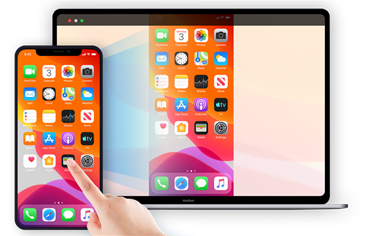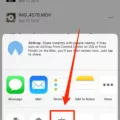The iPhone has become an integral part of our lives, offering a wide range of features and capabilities. One such feature that can greatly enhance your iPhone experience is the ability to mirror your iPhone screen to your iMac. This can be incredibly useful for a variety of reasons, such as sharing photos or videos with friends and family, presenting slideshows or presentations, or even just enjoying your favorite mobile games on a larger screen. In this article, we will explore how to mirror your iPhone screen to your iMac using AirPlay.
Before we get started, it’s important to ensure that both your iPhone and iMac are connected to the same Wi-Fi network. This is crucial for the AirPlay feature to work seamlessly. Once you have confirmed that both devices are connected to the same network, you can proceed with the following steps.
Step 1: On your iPhone, swipe up from the bottom or the top of the screen to access the Control Center. This is where you will find the AirPlay options.
Step 2: In the Control Center, you will see various options, including the Screen Mirroring option. Tap on this option to initiate the screen mirroring process.
Step 3: After tapping on the Screen Mirroring option, a list of available devices will appear on your iPhone screen. Look for your iMac in this list and select it. Your iPhone will then establish a connection with your iMac.
Step 4: Once the connection is established, your iPhone screen will be mirrored on your iMac. You can now navigate through your iPhone as you normally would, and everything you do will be displayed on the larger screen of your iMac.
It’s important to note that both your iPhone and iMac need to support AirPlay for this feature to work. Additionally, it’s always a good idea to ensure that both devices are updated to the latest software versions, as this can help prevent any compatibility issues.
If you encounter any difficulties during the screen mirroring process, it may be helpful to restart both your iPhone and iMac, as well as ensuring that they are in close proximity to each other. Sometimes, a simple restart can resolve any connectivity issues that may arise.
Mirroring your iPhone screen to your iMac can be a valuable tool for a variety of purposes. Whether you want to share photos or videos, present a slideshow, or simply enjoy your favorite mobile games on a larger screen, AirPlay makes it possible. By following the steps outlined in this article, you can easily mirror your iPhone screen to your iMac and enhance your overall iPhone experience.

Can You Mirror the iPhone Screen to iMAC?
It is possible to mirror your iPhone screen to your iMac. To do this, follow the steps below:
1. Ensure that both your iPhone and iMac are connected to the same Wi-Fi network.
2. On your iPhone, open the Control Center by swiping down from the top right corner (on iPhone X or later) or swiping up from the bottom of the screen (on iPhone 8 or earlier).
3. In the Control Center, look for the “Screen Mirroring” option and tap on it.
4. A list of available devices will appear on your iPhone screen. Look for your iMac in the list and tap on it.
5. On your iMac, you may be prompted to enter a passcode to allow the connection. Enter the passcode if required.
6. Once the connection is established, your iPhone screen will be mirrored on your iMac.
It’s worth noting that both your iPhone and iMac need to support AirPlay for this feature to work. Additionally, some older iMac models may not be compatible with AirPlay. To check if your iMac is compatible, go to the Apple menu on your iMac, select “System Preferences,” and then click on “Displays.” If you see an option for “AirPlay Display,” your iMac supports AirPlay.
Mirroring your iPhone screen to your iMac can be useful for various purposes, such as presenting content, sharing videos or photos with a larger audience, or simply using your iMac as a larger display for your iPhone.
How to Display Your iPhone On Your iMac?
To display your iPhone screen on your iMac, you can use AirPlay, a wireless technology that allows screen mirroring. Here are the steps to follow:
1. Ensure that both your iPhone and iMac are connected to the same Wi-Fi network. This is necessary for them to communicate with each other.
2. On your iPhone, swipe up from the bottom or the top of the screen to access the Control Center. This is where you’ll find various options and settings.
3. In the Control Center, look for the “Screen Mirroring” option. It may also be labeled as “AirPlay” or have an icon resembling a rectangle with an arrow pointing upwards. Tap on this option.
4. After tapping on “Screen Mirroring,” a list of available devices will appear. Look for your iMac in the list and tap on it to select it.
5. If prompted, enter the passcode displayed on your iMac to establish the connection between the two devices.
6. Once the connection is established, your iPhone screen will be mirrored on your iMac. You can now view and interact with your iPhone’s screen on the larger display of your iMac.
That’s it! You have successfully displayed your iPhone screen on your iMac using AirPlay. Enjoy the convenience of working with a larger screen and taking advantage of the features offered by both devices.
Why Can’t You Mirror Your iPhone to Your iMac?
There could be several reasons why you are unable to mirror your iPhone to your iMac. Here are some possible causes and solutions:
1. Check AirPlay compatibility: Ensure that both your iPhone and iMac support AirPlay. Older models may not have this capability.
2. Verify software updates: Make sure both devices are running the latest software versions. Outdated software can cause compatibility issues. Update your iPhone and iMac to the latest available versions.
3. Check Wi-Fi network: Ensure that both devices are connected to the same Wi-Fi network. AirPlay requires devices to be on the same network for mirroring to work.
4. Restart devices: Sometimes, a simple restart can fix connectivity issues. Restart both your iPhone and iMac and try mirroring again.
5. Check AirPlay settings: On your iMac, go to System Preferences > Displays > AirPlay Display. Make sure that “Enable AirPlay Display” is checked. Also, verify that your iPhone’s AirPlay settings are correctly configured.
6. Disable VPN or Firewall: If you have a Virtual Private Network (VPN) enabled or a firewall running on your iMac, try disabling them temporarily. VPNs and firewalls can sometimes interfere with AirPlay connections.
7. Reset network settings: On your iPhone, go to Settings > General > Reset > Reset Network Settings. This will reset all network settings on your device. Afterward, reconnect to your Wi-Fi network and try mirroring again.
8. Test with other devices: If you have access to another AirPlay-compatible device, such as an Apple TV, try mirroring your iPhone to that device. This will help determine if the issue is specific to your iMac or if it’s a broader problem.
If none of these solutions work, it’s advisable to contact Apple Support for further assistance. They can provide more specific troubleshooting steps based on your devices and software versions.
Conclusion
The iPhone is a powerful and versatile device that offers a wide range of features and functionalities. From its sleek design to its intuitive user interface, the iPhone has become a popular choice for smartphone users around the world. With its advanced camera capabilities, high-quality display, and seamless integration with other Apple devices, the iPhone offers a seamless user experience.
One of the standout features of the iPhone is its ability to mirror the screen to a Mac using AirPlay. This feature allows users to easily share their iPhone screen on a larger display, making it perfect for presentations, watching videos, or playing games. By simply connecting both devices to the same Wi-Fi network and selecting the Mac from the screen mirroring options on the iPhone, users can effortlessly mirror their iPhone screen onto their Mac.
Furthermore, AirPlay ensures that the mirroring process is smooth and seamless, with minimal lag or delay. This makes it ideal for tasks that require real-time interaction, such as gaming or video streaming. Additionally, AirPlay-enabled devices can be easily updated to the latest software, ensuring compatibility and optimal performance.
The ability to mirror the iPhone screen to a Mac using AirPlay adds an extra level of convenience and functionality to the already impressive iPhone. Whether for work or leisure, this feature allows users to easily share and enjoy content on a larger screen, enhancing the overall user experience. With its seamless integration and intuitive interface, the iPhone continues to set the benchmark for smartphones, providing users with a powerful and enjoyable mobile experience.







